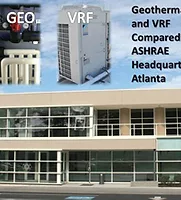On September 24, the ASHRAE headquarters in Atlanta was the sight of American Ground Water Trust’s (AGWT) Geothermal Workshop. The AGWT facilitates workshops around the globe on varying technologies, providing continuing education credits for architects, engineers and contractors. The workshopwas of considerable interest to HVAC and plumbing professionals because the headquarters building is a living laboratory with two different types of HVAC systems installed: a variable refrigerant flow (VRF) system serves the first floor, and a geothermal heat pump (GHP) system serves the second floor.
Information on ASHRAE building from ASHRAE Journal technical features in September and December, 2014: Performance of HVAC systems at ASHRAE HQ
In the HVAC industry, hydronic-based HVAC systems have been the basis of design since the beginning. In recent years, technological advances have helped to develop variable refrigerant flow (VRF) systems into a more dependable technology. VRF systems range from unitary or packaged systems, to systems with multiple evaporators that are interconnected by refrigerant lines. Because of the high-efficiency associated with variable speed compressors that are able to match the loads of the buildings they serve, remarkable energy efficiency ratings may be claimed in certain instances, and this can be confusing to those of us trying to select the best HVAC system for our application.
The ASHRAE headquarters is two stories with similar conditioned areas on the first and second floors, and it was designed with a geothermal HVAC system on the second floor (15,558 square feet), and a variable refrigerant flow (VRF) system on the first floor (18,226 square feet).The building has a dedicated outdoor air system (DOAS) for supplying fresh air to both floors.
In 2008, ASHRAE’s headquarters went through a major remodel with the object in mind to evaluate sustainable building energy performance. Included were improvements such as lighting, solar PV and insulation. In order to facilitate reporting of performance, an array of more than 1600 sensors to monitor HVAC performance was installed in the building. Data loggers have been used to provide historical data, and they continue to provide data today. With all of that data available, it was only a matter of time...
In 2013, a research team from Oak Ridge National Laboratory (ORNL) and Oklahoma State University (OSU) were contracted to evaluate the performance of the HVAC systems at the ASHRAE building. Xiaobing Liu, PhD, and J.D. Spitler, PhD teamed up to crunch the data. These researchers have been studying the relative performance of VRF and GHP that control the temperatures in the ASHRAE building. Another HVAC expert, Greg Cunniff, co-wrote the book, "Modern Geothermal HVAC Engineering and Control Applications," (McGraw-Hill Professional, 2013) and had some comments about variable refrigeration systems. In Chapter 14, Cunniff said that VRF systems claim that even in heating climates, they do not need backup heat (relating back to GHPs ability to operate without back-up heat). However, they achieve this by speeding up the compressor to double the speed to produce higher heating capacities at lower ambient temperatures.
Reprinted with permission from: Modern Geothermal HVAC Engineering and Control Applications, McGraw-Hill Professional, ISBN 0071792686/9780071792684 by: Jay Egg, Greg Cunniff, Carl Orio
This is at the expense of efficiency. If a variable-speed compressor has a higher efficiency at reduced speed, it will have a lower efficiency at increased speed. This information is not published by the VRF manufacturers. However, this can be seen in the monthly breakdown for 2011 for the heating months. The difference in heating consumption is more than the AHRI HSPF ratings would indicate. The biggest difference in energy consumption of the geothermal and VRF systems is not cooling, but heating. One of the figures in the book illustrates the need to build a heated mechanical room for the VRF condenser in cold climates.
Additionally chemical refrigerant must move at a higher velocity in order to entrain (or move-along) the refrigerant oil necessary to lubricate the compressor. This translates into greater pumping power consumption per BTU than water-based hydronic systems. This is illustrated in the table Cunniff published in Chapter 14. Still, Cunniff says that manufacturers use what might be deemed misleading seasonal energy efficiency ratings (SEER). These are often confusing because seasonal ratings differ in significant ways from the standard energy efficiency rating (EER) system for GHPs. To go one step further Greg re-rated several systems with integrated energy efficiency ratings (IEER) and integrated part load values (IPLV). These values integrate all of the peripheral energy consumption for fans and pump, etc.
Back at the ASHRAE building, Dr. Liu and Dr. Spitler found that the when they normalized the power consumptions of the GHP and VRF systems with floor space conditioned by each system, the energy use (kWh/ft2) over the two year period indicated was 44 percent less for GHP than the VRF system. The U.S. Department of Energy confirms that geothermal heat pumps are among the most efficient and comfortable heating and cooling technologies available because they use the earth’s natural heat to provide heating, cooling, and often, water heating. Geothermal heat pump systems have an average 20 years plus life expectancy for the heat pump itself. Additionally, they move between three and five times the energy they consume between a building’s interior space and the ground.
Information from U.S. DOE Guide to Geothermal Heat Pumps
Industry stakeholders have created a website with vast resources to educate the public on geothermal heat pumps. The Geothermal Day website, www.geothermalday.com, aims to raise awareness about environmental and economic benefits of geothermal energy and its vital role in building a clean and secure energy future. We are inviting industry partners, communities, businesses and educators to join efforts to advance further understanding and acceptance of geothermal technology as an unlimited, renewable form of energy. Join us by co-creating and sharing educational resources and participating in interactive activities in local communities and online.
Special thanks to PixyJackPress and Donal Blaise Lloyd (author) for use of illustrations from the book, “Geo Power.”
For more exclusive content, visit this column in the November digitial edition.
Jay Egg is a geothermal consultant, writer and the owner of EggGeothermal. He has co-authored two textbooks on geothermal HVAC systems published by McGraw-Hill Professional. He can be reached at [email protected].






